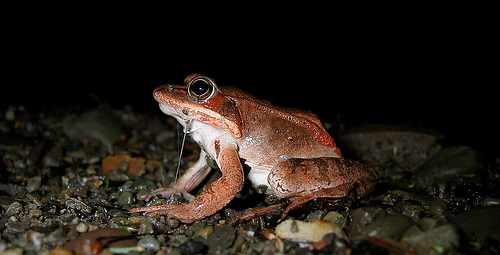Wood frogs are wonders of natural science.
- Wood frogs are frogs native to forests that feature pools of water, in northern parts of North America.
- The scientific name of a wood frog is Lithobates sylvaticus and it is from the family Ranidae, the family of true frogs.
- Wood frogs grow to lengths of around 3.5 to 7.6 centimetres (1.4 to 3 inches), and they deter predators with their poison glands and shrill noises they can make.
- Typically, a wood frog is coloured brown, brown-red or tan in colour, and occasionally green or grey, and it has a dark band covering its eye.
- The diet of wood frogs typically consists of insects, algae, worms, molluscs, and amphibious eggs and larvae.
Wood Frog
Image courtesy of Dave Huth/Flickr
- Wood frogs shut down during freezing winter temperatures, and they survive the freezing/thawing process numerous times due to the content of glucose and urea in their system, which reduces dehydration and the formation of ice in their cells.
- Female wood frogs lay up to 3000 eggs in temporary water pools, that later hatch into tadpoles, then morph into adults; and they generally only reproduce once in their life, which is 3 to 5 years.
- Wood frogs generally live alone in wet forest habitats during summer, and live in hilly habitats during winter.
- Male wood frogs have a brighter coloured skin tone, although they are generally smaller than females, and the females usually live longer than the males.
- Deforestation of their natural habitat threatens certain populations of wood frogs, although the population as a whole is not under threat at this stage.
Bibliography:
Kiehl K, Lithobates sylvaticus, 2015, Animal Diversity, http://animaldiversity.org/accounts/Lithobates_sylvaticus/
Wood frog, 2015, Wikipedia, http://en.wikipedia.org/wiki/Wood_frog








